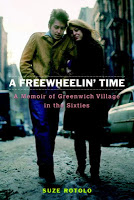Read Your Way Around the World invites you to Greenwich Village.
 Beginning in 1640 The Village: 400 years of beats and bohemians, radicals and rogues: a history of Greenwich Village (M) by John Strausbaugh profiles a cast of characters who have made this New York neighbourhood famous – artists, musicians, writers, actors, activists and rogues.
Beginning in 1640 The Village: 400 years of beats and bohemians, radicals and rogues: a history of Greenwich Village (M) by John Strausbaugh profiles a cast of characters who have made this New York neighbourhood famous – artists, musicians, writers, actors, activists and rogues.
Early in its history Greenwich Village was the countryside haven to which New Yorkers fled to escape an outbreak of yellow fever and eventually grew to attract society’s outcasts, ranging from freed slaves to nonconformists seeking to live amongst like-minded people. Those familiar with the geography will be able to pick vividly where Poe lived, where Dylan Thomas drank and where Bob Dylan performed as a newcomer to the Village scene.
 |
| (C) Christine L. Walker |
While Greenwich Village is described as an incubator of great artistic, cultural and political ideas, Strausbaugh also tells of a Greenwich Village that lured in the dreamers who were looking to connect but found themselves unable to cope and succumbed to alcoholism, drug addiction and worse. The Village is not just a physical place but an evolving culture unto itself which grew from centuries of attracting creative, radical and rebellious thinkers. It features a huge cast of characters – far too large to fully take in – some of the stories that resonated with me included Mabel Dodge, Djuna Barnes, all of the Beat Generation and the terrible and tragic Triangle Shirtwaist Fire. There are so many more stories, too many to be absorbed in one reading.
Missing from the book is a map to show you where all these events took place, so print yourself off a copy and keep in on hand for a more complete reading experience.
Jonathan Lethem has written a family saga which features three generations of American radicals whose passionate beliefs take the reader from the communist movement in the 1930s to present day Occupy protests.
 In Dissident Gardens (M) “At the center of Jonathan Lethem’s superb new novel stand two extraordinary women: Rose Zimmer, the aptly nicknamed Red Queen of Sunnyside, Queens, is an unreconstructed Communist who savages neighbors, family, and political comrades with the ferocity of her personality and the absolutism of her beliefs. Her precocious and willful daughter, Miriam, equally passionate in her activism, flees Rose’s influence to embrace the dawning counterculture of Greenwich Village. … As the decades pass—from the parlor communism of the ’30s, McCarthyism, the civil rights movement, ragged ’70s communes, the romanticization of the Sandinistas, up to the Occupy movement of the moment—we come to understand through Lethem’s extraordinarily vivid storytelling that the personal may be political, but the political, even more so, is personal.” publisher
In Dissident Gardens (M) “At the center of Jonathan Lethem’s superb new novel stand two extraordinary women: Rose Zimmer, the aptly nicknamed Red Queen of Sunnyside, Queens, is an unreconstructed Communist who savages neighbors, family, and political comrades with the ferocity of her personality and the absolutism of her beliefs. Her precocious and willful daughter, Miriam, equally passionate in her activism, flees Rose’s influence to embrace the dawning counterculture of Greenwich Village. … As the decades pass—from the parlor communism of the ’30s, McCarthyism, the civil rights movement, ragged ’70s communes, the romanticization of the Sandinistas, up to the Occupy movement of the moment—we come to understand through Lethem’s extraordinarily vivid storytelling that the personal may be political, but the political, even more so, is personal.” publisher
Strausbaugh’s The Village features an interesting glimpse of Suze Rotolo who was associated with Bob Dylan in the early 1960s, but who chose to remain private about this relationship until shortly before her death when she wrote A Freewheelin’ Time: a memoir of Greenwich Village in the sixties (M).
 “Suze Rotolo’s story is rich in character and setting, filled with vivid memories of those tumultuous years of dramatic change and poignantly rising expectations when art, culture, and politics all seemed to be conspiring to bring our country a better, freer, richer, and more equitable life. She writes of her involvement with the civil rights movement and describes the sometimes frustrating experience of being a woman in a male-dominated culture, before women’s liberation changed the rules for the better. And she tells the wonderfully romantic story of her sweet but sometimes wrenching love affair and its eventual collapse under the pressures of growing fame.” publisher
“Suze Rotolo’s story is rich in character and setting, filled with vivid memories of those tumultuous years of dramatic change and poignantly rising expectations when art, culture, and politics all seemed to be conspiring to bring our country a better, freer, richer, and more equitable life. She writes of her involvement with the civil rights movement and describes the sometimes frustrating experience of being a woman in a male-dominated culture, before women’s liberation changed the rules for the better. And she tells the wonderfully romantic story of her sweet but sometimes wrenching love affair and its eventual collapse under the pressures of growing fame.” publisher


